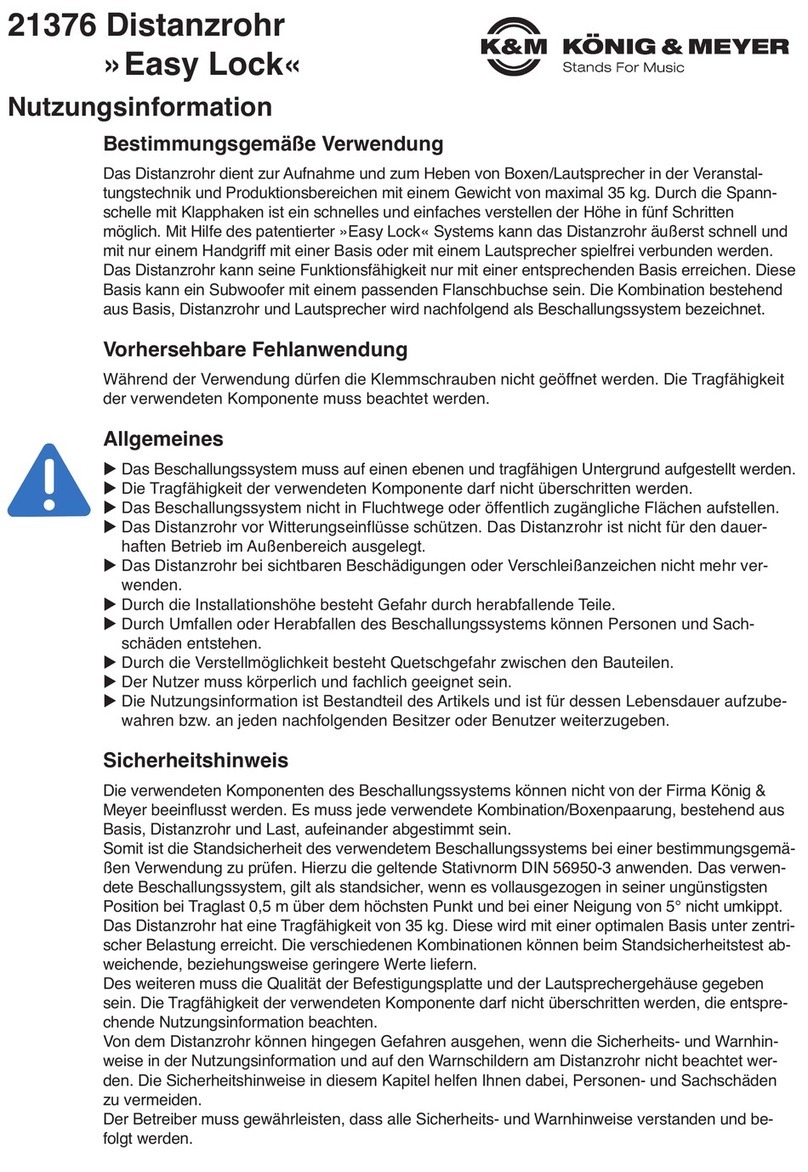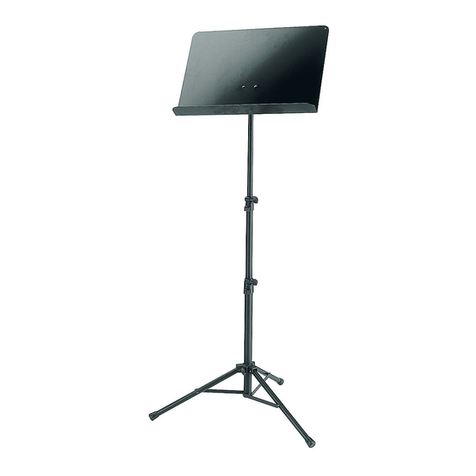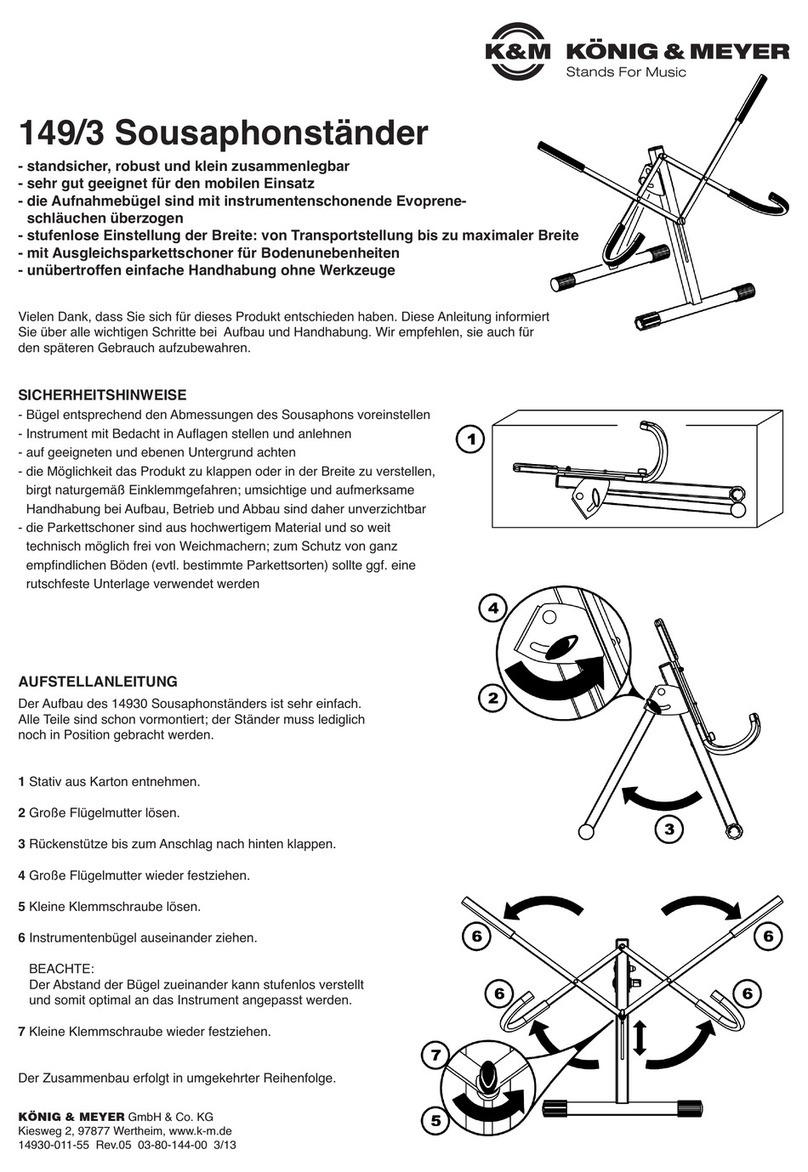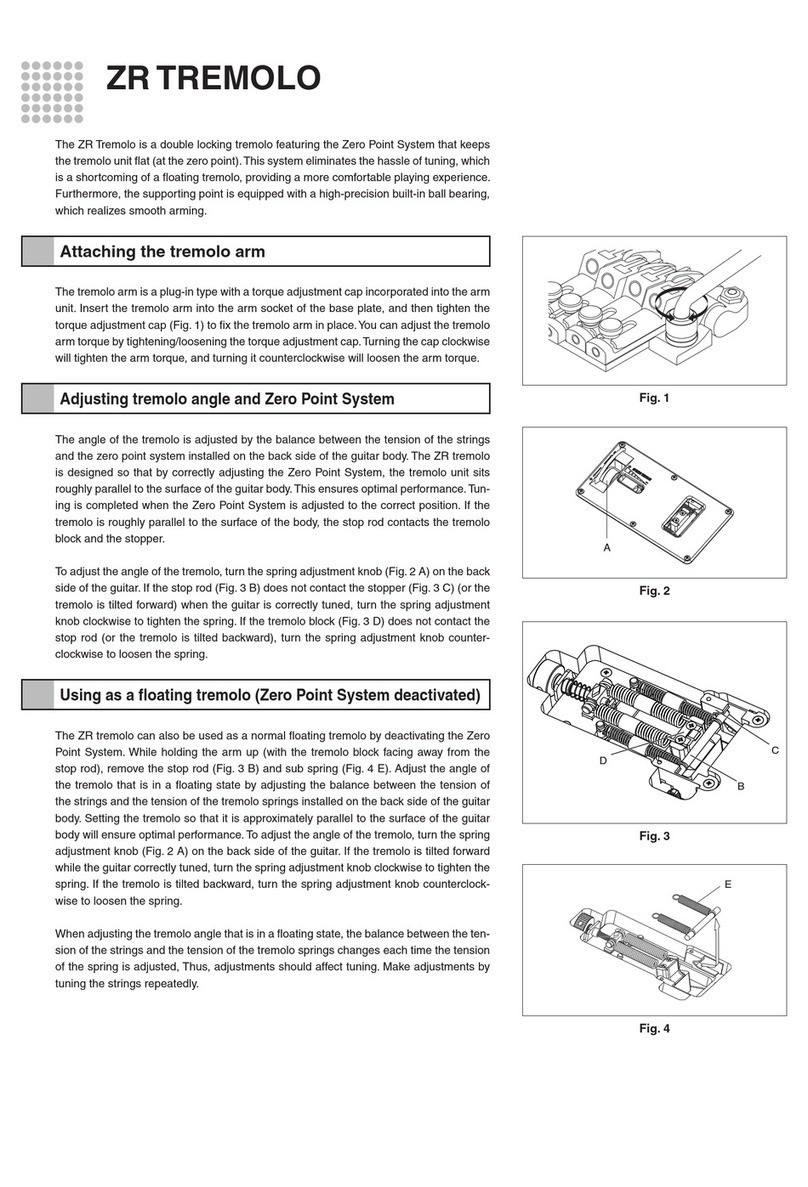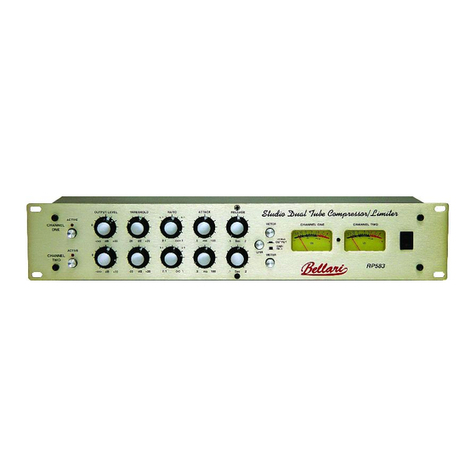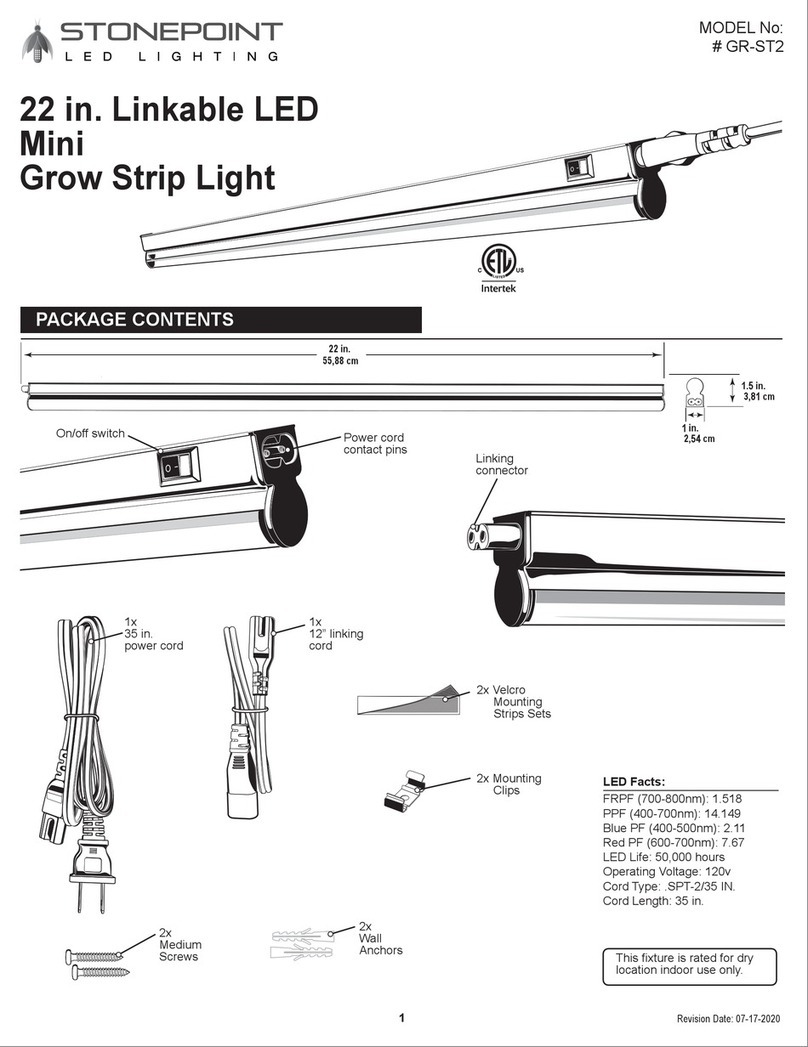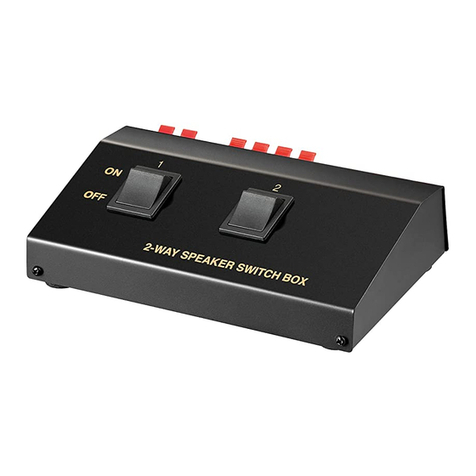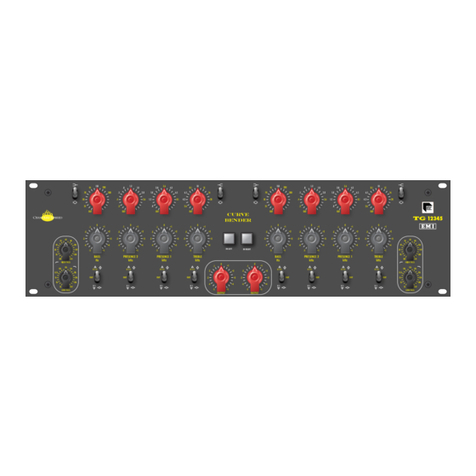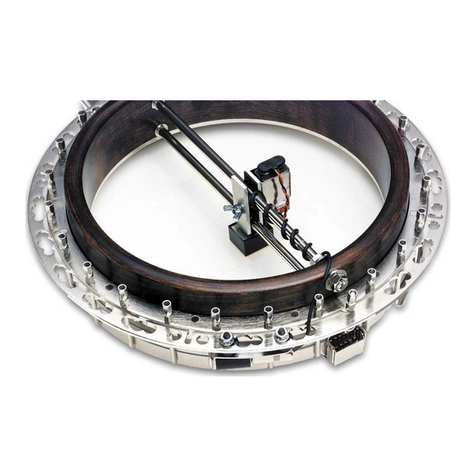Konig & Meyer 15060 User manual

15060 Bassklarinettenständer
- standsicher, robust und klein zusammenlegbar, mithin sehr gut geeignet für den mobilen Einsatz
- äußerst flexibler Haltebügel:
- sehr instrumentenschonend (seitliche Gummibacken; Filzrückwand)
- Breite variabel einstellbar durch Umstecken der Gummibacken
- höhenverstellbar; sufenlos von 700 - 1200 mm
- Auf- und Abbau ohne Werkzeuge
SICHERHEITSHINWEISE
- Damit das Instrument in der Schale platziert werden kann,
- ist es erforderlich den Stachel auszufahren.
- Erfahrungsgemäß beträgt dieser Abstand 5-8 cm, jedoch ist
- es erforderlich jedes Instrument diesbezüglich zu prüfen.
- Instruments mit Bedacht in Auflageschale stellen
- und Korpus an Haltebügel anlehnen.
- Auf geeigneten und ebenen Untergrund achten.
- Die Möglichkeit das Produkt zusammenzuklappen oder
- zu verstellen, birgt naturgemäß Einklemmgefahren;
- umsichtige und aufmerksame Handhabung bei Aufbau,
- Betrieb und Abbau sind daher unverzichtbar.
- Die Parkettschoner sind aus hochwertigem Material und so
- weit wie möglich frei von Weichmachern; zum Schutz von
- ganz empfindlichen Böden (evtl. bestimmte Parkettsorten)
- sollte ggf. eine rutschfeste Unterlage verwendet werden
AUFBAUANLEITUNG
Der Aufbau des 15060 Baßklarinettenständers ist sehr einfach.
Alle Teile sind schon vormontiert; das Stativ muss lediglich
noch in Position gebracht werden.
1. Stativ aus Karton entnehmen
2. Klemmschraube lösen
3. Füsse auseinanderziehen...
4. ...bis Verbindungsstreben waagerecht stehen
5. Klemmschraube wieder fest anziehen
6. Klemmung an der Spannschelle lösen,
6. Auszugrohr aus bzw. einfahren,
6. Klemmung wieder festziehen
7. Der Zusammenbau erfolgt in
7. umgekehrter Reihenfolge
Vielen Dank, dass Sie sich für dieses Produkt entschieden haben. Diese Anleitung informiert Sie über alle wichtigen Schritte bei
Aufbau und Handhabung. Wir empfehlen, sie auch für den späteren Gebrauch aufzubewahren.
KÖNIG & MEYER GmbH & Co. KG
Kiesweg 2, 97877 Wertheim, www.k-m.de
15060-011-55 Rev.08 03-80-217-00 10/18
6.
3.
2.
5.
4.

BENUTZERHINWEISE / FUNKTIONEN
A. HÖHE
A. - Klemmung an der Spannschelle lösen,
A. - Auszugrohr aus- bzw. einfahren, Klemmung
A. - wieder festziehen.
A. - Je nach Stellung der Füße und Position
A. - des Auszugrohres erreicht das Stativ
A. - eine Höhe zwischen 700 und 1200 mm.
PRÜFEN, INSTANDHALTEN, REINIGEN
- bei Wartungsarbeiten auf evtl. Gefährdungen achten (Einklemmen, Anstoßen)
- zur Reinigung am besten ein leicht feuchtes Tuch und ein nicht scheuerndes Reinigungsmittel benutzen.
FEHLERSUCHE (F) und BESEITIGUNG (B)
FF: Stativ wackelt B: Boden prüfen, Fußkreis verstellen, Klemmschrauben anziehen (siehe Fig. 4und 5)
F: Höhe passt nicht B: Auszugrohr einstellen (siehe Fig. A)
F: Bügel hält nicht B: Klemmutter nachziehen, Gummischeiben und Gewinde prüfen (siehe Fig. B)
TECHNISCHE DATEN / SPEZIFIKATIONEN
Material
Rohre, Bügel, Streben, Schale - Stahl, pulverbeschichtet Farbe schwarz
Schrauben, Nieten - Stahl, verzinkt
Parkettschoner, Backen - Thermoplastischer Elastomer (TPE), schwarz
Bügelrückwand - Filz
Schellen, Führungen, Griffe - PA
Traglast Baßklarinette
Abmessungen Fußkreisdurchmesser: max. 800 mm, Höhe: 700mm - 1200 mm
Packmaß, Gewicht 175 x 135 x 645 mm; 2,9 kg
Karton, Gewicht 195 x 140 x 660 mm; 3,3 kg
B. BÜGEL
B. - NEIGUNG
B. - Große Klemmutter lösen, Bügel in gewünschte
B. - Neigung bringen, Klemmutter wieder fest anziehen.
B. - BREITE
B. - Durch Umstecken der Gummibacken kann der
B. - Abstand des Bügels variiert werden:
B. - a. 67 - 87 mm - Lamellen der Gummibacken sind aussen
B. - b. 57 mm - Lammellen der Gummibacken sind innen
C. INSTRUMENT PLATZIEREN
C. 1. Sicherstellen, dass der Stachel ausreichend
C. 1. weit herausragt (X cm). Dies dient der
C. 1. Wahrung des Sicherheitsabstandes
C. 1. zwischen Instrument und Fußrohr.
C. 2. Erst den Stachel des Instruments in die Schale
C. 2. stellen...
C. 3. ...und anschließend an den Bügel anlehnen.
Gummibacken abziehen
wenden
und wieder aufstecken
a. b.

15060 Bass clarinet stand
- Stable, robust with a small footprint, well-suited for use on the road
- Extremely flexible support arm:
-very gentle to the instruments (lateral rubber pads; felt covered back)
-width variably adjustable by changing the rubber pads
- Height adjustable; variable adjustment from 700 – 1200 mm
- Assembly and disassembly without tools
SAFETY NOTES
- Carefully place the instrument into the kickstand cup and
-lean the body onto the support arm.
- Be sure that the surface is suitable and level
- The fact that the product is collapsible and adjustable,
-can result in the risk of pinching or wedging of your fingers;
-careful handling during assembly, operation, and
-disassembly is indispensable.
- The endcaps are made of high-quality material and to the
-extent possible free of softening agents; to protect
-particularly delicate floors (possibly certain wood floor
-types) a slip resistant pad should be used, if needed.
SETUP INSTRUCTIONS
Setting up the 15060 Bass Clarinet Stand is very easy.
The stand comes preassembled and only needs to be put in
position.
1. Take the stand and support arm out of the box
2. Loosen the clamp screw a bit
3. Pull the legs apart...
4. ...until the connecting struts are level
5. Re-tighten the clamping screw
6. Loosen the clamping screw of the clamp/bracket;
6. extend or retract the extension tube,
6. re-tighten the clamp bracket
7. Disassemble in reverse order
Thank you for choosing this product. This instruction manual informs you about the important steps to set up and handle the product.
We recommend to keep the manual in a separate place for a possible later use.
KÖNIG & MEYER GmbH & Co. KG
Kiesweg 2, 97877 Wertheim, www.k-m.de
15060-011-55 Rev.08 03-80-217-00 10/18
6.
3.
2.
5.
4.

USAGE NOTES / FUNCTION
A. HEIGHT
A. - Loosen the clamping screw of the clamp bracket,
A. - Re-tighten clamp bracket after extending/retracting
A. - the extension tube.
A. - Depending on the position of the legs and the
A. - position of the extension tube a height of between
A. - 700 and 1200 mm can be reached.
CHECK, MAINTENANCE, CLEANING
- in the event of maintenance pay attention to possible risks (wedging, bumping into the stand)
- To care for the product, use a damp cloth and non-abrasive cleaning agent.
FAULT-FINDING (F) and REPAIR (R)
F: Stand is not stable R: Check surface, adjust the base, tighten the clamp screws (see illustration 4and 5)
F: The height needs to be adjusted R: Adjust the extension tube (see illustration A)
F: Bracket does not hold R: Tighten the clamping nut, check the rubber washers and the thread (see illustration B)
TECHNICAL DATA / SPECIFICATIONS
Material
Tubes, support arm, struts, V-shaped base - Steel, powder-coated colour black
Screws, rivets - Steel, galvanized
Rubber caps, rubber pads - Thermoplastic elastomer (TPE), black
Support arm back - Felt
Brackets, rails, grips - PA
Load Bass clarinet
Dimensions Base circumference: max. 800 mm, Height: 700mm - 1200 mm
Pack size, weight 175 x 135 x 645 mm; 2.9 kg
Box, weight 195 x 140 x 660 mm; 3.3 kg
B. SUPPORT ARM
B. - ANGLE
B. - Loosen the large clamp nut, place the support arm
B. - in the desired angle, tighten the clamp nut.
B. - WIDTH
B. - Depending on how the rubber pads are placed
B. - on the support arm the dimensions range from:
B. - a. 67 - 87 mm - The ribs of the rubber pads face outwards
B. - b. 57 mm - The ribs of the rubber pads face inwards
C. PLACEMENT of the INSTRUMENT
C. 1. Make sure that the endpin protrudes
C. 1. sufficiently far (X cm). This ensures a
C. 1. safe distance between the instrument
C. 1. and the foot tube.
C. 2. First place the endpin of the instrument
C. 2. into the V-shaped base...
C. 3. ...and then place the clarinet in the bracket.
Remove the rubber
pads, turn them over
and put them back again
a. b.
Base circumference 800 mm
Table of contents
Languages:
Other Konig & Meyer Music Equipment manuals
